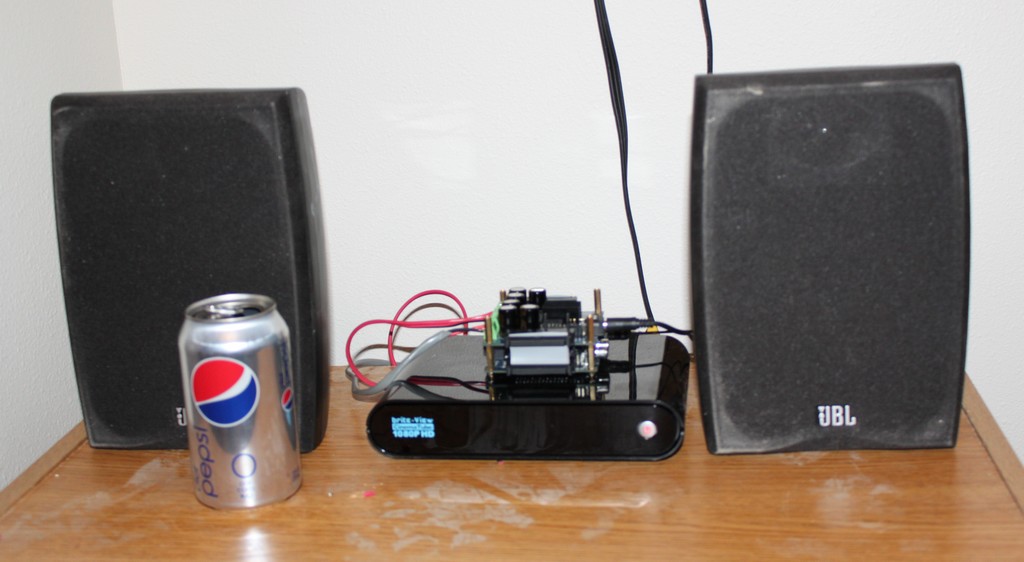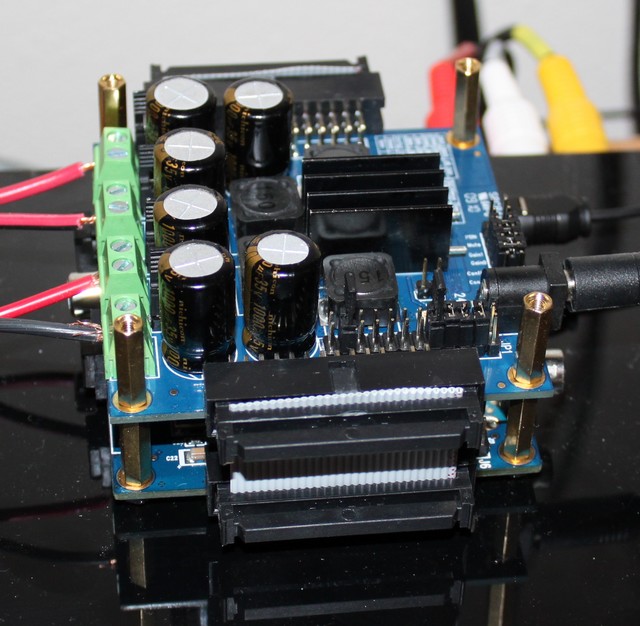DSP4YOU (www.minidsp.com) is a company that makes tiny audio DSP (digital signal processor) kits. For this particular review, I’ll be reviewing two of their cards, the MiniDIGI and the miniAMP. Like most of my reviews, lets start off with the picture:
The miniDIGI and miniAMP are the two little cards sitting on top of my CinemaTube. The pepsi can is shown for scale. Here’s a closeup of the MiniDIGI and MiniAMP without all of my extra junk:
The miniAMP is the card on top and is a class-D amplifier that take I2S digital audio signals and amplifies them for your speakers. You can use it in a four-channel configuration (four digital signals in, four speakers out) at 10W per channel, or you can use it in a bridged configuration for 20W per channel (two digital signals in, two speakers out).
The miniDIGI card is on bottom. It has two toslink inputs, two coaxial inputs, a toslink output, and a coaxial output. It takes the digital audio from your audio components (dvd/blu-ray, media player, etc) and outputs I2S digital signals for other products in the miniDSP family. It can also take I2S inputs and output them on the toslink/coaxial outputs.
By using just these two cards, we have an amplifier that accepts your digital input (coaxial or optical/toslink), amplifies it, and drives your speakers. It’s a nice compact solution. The real power would be obtained by adding one of the miniDSP cards which can be configured as a digital crossover or other functions, but that is territory for a future review.
My miniAMP and miniDIGI arrived direct from the manufacturer, shipped all the way from Hong Kong. To my great surprise, I ordered it on a wednesday and it arrived the following monday. That’s much quicker shipping than many products that I order locally here in the states. The boards are well-constructed and include standoffs and cables for chaining the boards together. A toslink cable is also included. The one thing that isn’t included is a power supply. You’ll need something capable of supplying 12V – 24V DC at an amp or two. I used a 22.5 VDC / 1.5 AMP power supply from my Roomba. Beware that the power connectors use the 2.5 mm barrel jack, which I found to be slightly uncommon — the 20-30 wall warts in my junk bin all used 2.1 mm connectors.
Getting the amplifier up and running took only a few minutes. I reconfigured one jumper to select my input (optical #1). It comes jumpered to automatically bridge the input to the output, so you could easily daisy-chain multiple units together (think of the possibilities; a separate amp for each speaker, connected by optical cables).
I connected the supplied toslink cable to my CinemaTube media player and the thing fired right up. It’s pretty close to being plug & play.
There are a couple of limitations that one should be aware of. The most notable is the lack of a volume control. There are two jumpers than can select any of four preconfigured gains (-3 DB, 3 DB, 9 DB, 12 DB), but that’s it. One answer is to control the audio from your source device. This works perfectly with the CinemaTube that I was using it with. Another option would be to use a post-amplifier volume control. The solution that the manufacturer likely had in mind would be to use one of the miniDSP cards inserted between the miniDIGI and miniAMP. The miniDSP cards have an optional input for a volume pot.
The real flexibility will come with adding a miniDSP card, and that will probably be one of my future projects. An interesting projects would be to use two sets of miniDIGI + miniDSP + miniAMP, build each set into a speaker, configure the miniDSP to function as a digital crossover, and have this fancy amplifier-embedded speaker contraption. Such a configuration would get pricey ($70/miniDIGI, $60/miniAMP, $99/miniDSP) but it would be pretty darn slick when it was all done.
In short, an impressive product.


Hey that is a pretty neat little project. Do you think you could put this inside of a speaker? What does it sound like? Any better than stock?
I’ve been working on a similar project digital home theater pc /active crossover project that I have yet to get up and running. I got the idea from the link below. Similar theory…
http://www.home-speaker.net/index.html
Is that similar to what you are doing here?
Jon
Yes, I think one of the design goals of the manufacturer is that it could be put in a speaker. I haven’t tried to do so myself, although I it’s something I’d like to try sometime. As far as the sound, I’m afraid I’m not much of an audiophile — the best review I can give on sound quality is that it sounds pretty darn good to me!